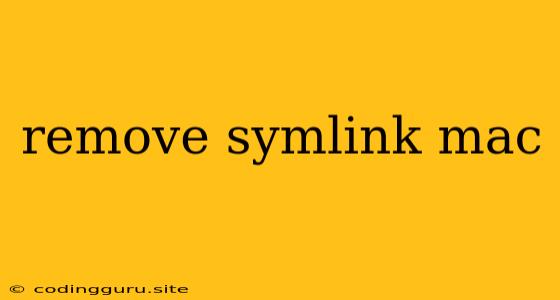Removing Symbolic Links on Your Mac: A Comprehensive Guide
Symbolic links, often referred to as symlinks, are powerful tools in macOS, allowing you to create shortcuts or aliases to files and directories located elsewhere on your system. While they can be incredibly useful for organizing your files and streamlining workflows, sometimes you might need to remove a symlink due to issues or simply to clean up your system.
This guide will provide you with a comprehensive understanding of removing symlinks on your Mac, covering the different scenarios and methods you can use.
Understanding Symbolic Links
Before diving into removing symlinks, it's crucial to understand what they are and how they work.
A symbolic link acts as a pointer to another file or directory. When you access a symlink, macOS automatically redirects you to the actual file or directory it points to. This allows you to access files or directories from multiple locations without actually creating copies.
Here's an analogy: Imagine you have a photo album in your attic. Instead of carrying the entire album around with you, you create a small picture of the album's cover and place it on your desk. This picture represents the actual album in the attic. Similarly, a symlink acts as a small picture representing the actual file or directory.
Why Would You Need to Remove a Symbolic Link?
There are several reasons why you might need to remove a symlink:
- Troubleshooting: If you suspect a symlink is causing problems, removing it can help identify the source of the issue.
- Cleaning up your system: Removing unused or unnecessary symlinks can free up space and improve system performance.
- Replacing a symlink: You might want to remove a symlink and create a new one pointing to a different file or directory.
- Security: In some cases, removing symlinks can be a security measure, preventing unauthorized access to sensitive files.
Identifying Symbolic Links
To remove a symlink, you first need to identify it. You can do this by using the ls command in Terminal:
ls -l
The -l flag displays the long listing format, which includes information about the file type. Symbolic links will have an "l" in the file type column.
For example, if you see the following output:
lrwxrwxrwx 1 user staff 22 Oct 26 14:32 my_symlink -> /path/to/real/file
This indicates that my_symlink is a symbolic link pointing to /path/to/real/file.
Methods to Remove a Symbolic Link
You can use the following methods to remove a symlink:
1. Using the rm Command
The rm command is the standard way to delete files and directories in macOS. To remove a symlink, use the following command:
rm my_symlink
Replace my_symlink with the name of the symbolic link you want to remove.
Important: The rm command will only remove the symlink itself. The actual file or directory it points to will remain untouched.
2. Using Finder
You can also remove symlinks using Finder. Follow these steps:
- Open Finder.
- Locate the symbolic link you want to remove.
- Right-click on the symlink and select "Move to Trash."
Important Considerations
- Be Careful with
rm: Thermcommand is powerful and can permanently delete files and directories. Always double-check that you are removing the correct symlink before executing the command. - Root-Owned Symlinks: If a symlink is owned by the root user, you might need to use the
sudo rmcommand to remove it. This requires administrator privileges. - Broken Symlinks: If the file or directory a symlink points to no longer exists, the symlink becomes broken. You can remove a broken symlink using the same methods as above.
Conclusion
Removing symbolic links in macOS is a straightforward process. Using either the rm command in Terminal or Finder, you can easily delete unwanted symlinks. Always be mindful of the files and directories you are working with, and ensure you are removing the correct symlinks to avoid unintended data loss.
